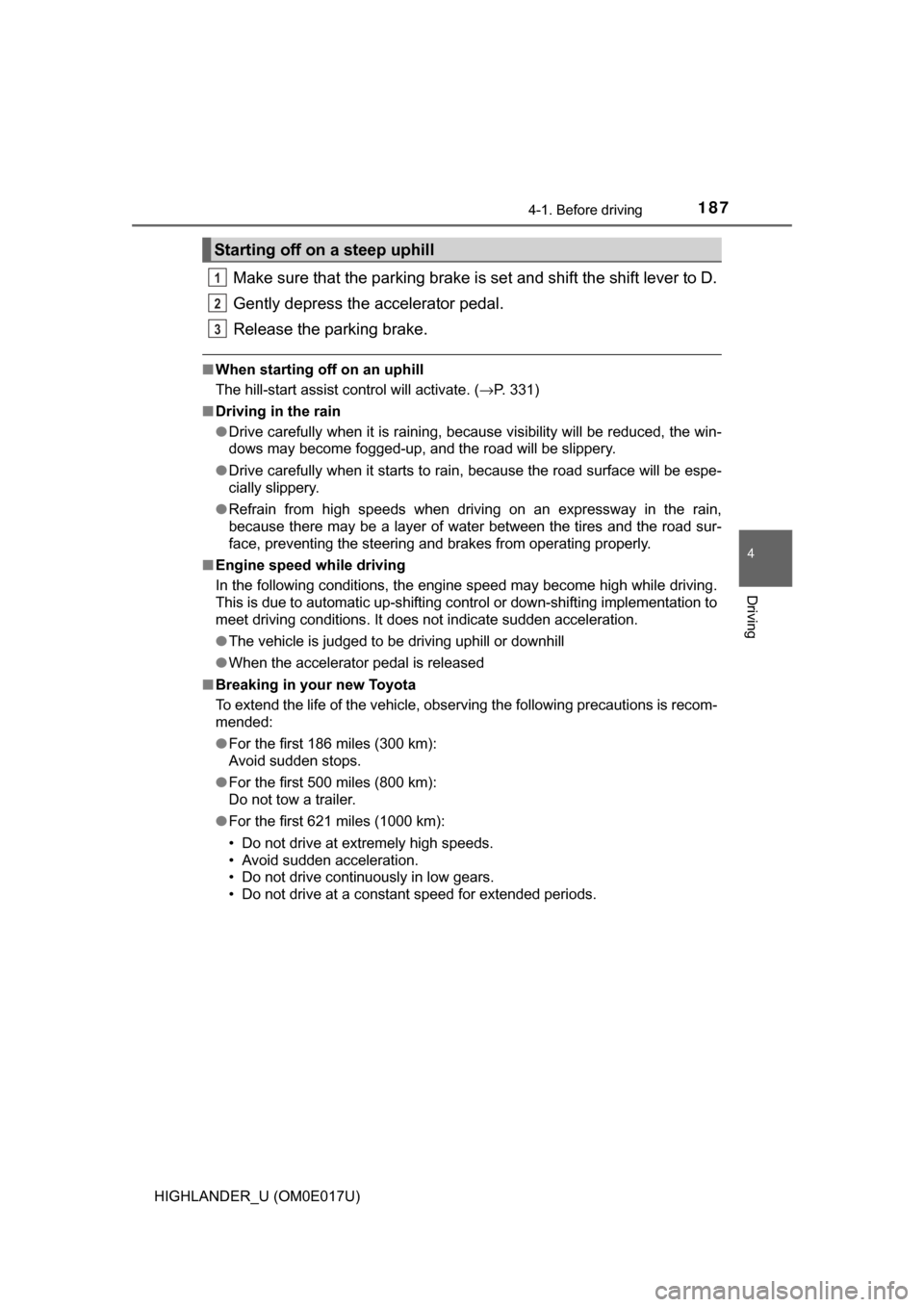2017 TOYOTA HIGHLANDER park assist
[x] Cancel search: park assistPage 3 of 732

3
1
8 7
6
5
4
3
2
9
HIGHLANDER_U (OM0E017U)
10
4-1. Before drivingDriving the vehicle ............. 186
Cargo and luggage............ 195
Vehicle load limits ............. 200
Trailer towing..................... 201
Dinghy towing.................... 217
4-2. Driving procedures Engine (ignition) switch (vehicles without a
smart key system) ........... 218
Engine (ignition) switch (vehicles with a smart
key system) ..................... 221
Automatic transmission .................... 227
Turn signal lever................ 233
Parking brake .................... 234
4-3. Operating the lights and wipers
Headlight switch ................ 235
Automatic High Beam ....... 239
Fog light switch ................. 243
Windshield wipers and washer ............................ 244
Rear window wiper and washer ............................ 248
4-4. Refueling Opening the fuel tank cap .......................... 250 4-5. Using the driving
support systems
Toyota Safety Sense P ........................... 254
PCS (Pre-Collision System) ........................... 261
LDA (Lane Departure Alert with steering
control) ............................ 275
Dynamic radar cruise control.............................. 285
Stop & Start system ........... 297
Rear view monitor system ............................. 307
BSM (Blind Spot Monitor)......... 316
• BSM function ................. 321
• RCTA function ............... 324
All-wheel drive lock switch .............................. 330
Driving assist systems ........................... 331
Downhill assist control system ............................. 337
4-6. Driving tips Winter driving tips .............. 339
Utility vehicle precautions ...................... 343
4Driving
Page 15 of 732

15Pictorial index
HIGHLANDER_U (OM0E017U)Fuel filler door . . . . . . . . . . . . . . . . . . . . . . . . . . . . . . . . . . . . P. 250
Refueling method . . . . . . . . . . . . . . . . . . . . . . . . . . . . . . . . . . . P. 250
Fuel type/fuel tank capacity . . . . . . . . . . . . . . . . . . . . . . . . . . . P. 653
Tires . . . . . . . . . . . . . . . . . . . . . . . . . . . . . . . . . . . . . . . . . . . . P. 531
Tire size/inflation pressure . . . . . . . . . . . . . . . . . . . . . . . . . . . . P. 660
Winter tires/tire chain . . . . . . . . . . . . . . . . . . . . . . . . . . . . . . . . P. 339
Checking/rotation/tire pressure warning system . . . . . . . . . . . P. 531
Coping with flat tires . . . . . . . . . . . . . . . . . . . . . . . . . . . . . . . . P. 608
Hood . . . . . . . . . . . . . . . . . . . . . . . . . . . . . . . . . . . . . . . . . . . . P. 516
Opening . . . . . . . . . . . . . . . . . . . . . . . . . . . . . . . . . . . . . . . . . . P. 516
Engine oil . . . . . . . . . . . . . . . . . . . . . . . . . . . . . . . . . . . . . . . . . P. 654
Coping with overheat . . . . . . . . . . . . . . . . . . . . . . . . . . . . . . . . P. 644
Warning messages . . . . . . . . . . . . . . . . . . . . . . . . . . . . . . . . . P. 593
Headlights/daytime running lights
*. . . . . . . . . . . . . . . . . . . P. 235
Daytime running lights
* /parking lights* . . . . . . . . . . . . . . P. 235
Front fog lights
* . . . . . . . . . . . . . . . . . . . . . . . . . . . . . . . . . . P. 243
Front turn signal lights/parking lights
*. . . . . . . . . . . . . . . . P. 233
Stop/tail lights . . . . . . . . . . . . . . . . . . . . . . . . . . . . . . . . . . . . P. 235
Hill-start assist control . . . . . . . . . . . . . . . . . . . . . . . . . . . . . . . P. 331
Downhill assist control system
*. . . . . . . . . . . . . . . . . . . . . . . . P. 337
License plate lights . . . . . . . . . . . . . . . . . . . . . . . . . . . . . . . . P. 235
Back-up lights
Shifting the shift lever to R . . . . . . . . . . . . . . . . . . . . . . . . . . . . P. 227
Side marker lights . . . . . . . . . . . . . . . . . . . . . . . . . . . . . . . . . P. 235
Turn signal lights . . . . . . . . . . . . . . . . . . . . . . . . . . . . . . . . . . P. 233
6
7
8
Light bulbs of the exterior lights for driving
(Replacing method: P. 556, Watts: P. 663)
*: If equipped
9
10
11
12
13
14
15
16
17
Page 18 of 732

18Pictorial index
HIGHLANDER_U (OM0E017U)
■Switches
Automatic High Beam switch . . . . . . . . . . . . . . . . . . . . . . . . P. 239
Stop & Start cancel switch
*1 . . . . . . . . . . . . . . . . . . . . . . . . P. 298
Camera switch
*1, 2
Power back door switch*1 . . . . . . . . . . . . . . . . . . . . . . . . . . P. 123
Windshield wiper de-icer switch . . . . . . . . . . . . . . . . . P. 438, 445
Heated steering wheel switch
*1. . . . . . . . . . . . . . . . . . . . . . P. 456
Intuitive parking assist switch
*1, 2
1
2
3
4
5
6
7
Page 89 of 732

892. Instrument cluster
2
Instrument cluster
HIGHLANDER_U (OM0E017U)
The indicators inform the driver of the operating state of the vehicle’s
various systems.
Indicators
Turn signal indicator
( →P. 233) LDA (Lane Departure
Alert with steering con-
trol) indicator
(
→P. 275)
(U.S.A.)
Headlight indicator
(→P. 235)*2, 3 Intuitive parking assist
indicator
(Canada)
Tail light indicator
(→P. 235) *2BSM (Blind Spot Moni-
tor) indicator( →P. 316)
Headlight high beam
indicator ( →P. 236)
*2, 6, 7BSM (Blind Spot Moni-
tor) outside rear view
mirror indicators
(→P. 316)
Automatic High Beam
indicator ( →P. 239)
*1, 4 Slip indicator ( →P. 333)
*2Front fog light indicator
(→P. 243)*1VSC OFF indicator
(→P. 333)
Dynamic radar cruise
control (constant speed
control mode) indicator
( →P. 293)
*1, 2All-wheel drive lock indi-
cator ( →P. 330)
Dynamic radar cruise
control (vehicle-to-vehi-
cle distance control
mode) indicator
( →P. 289)
*2Downhill assist control
system indicator
(→P. 337)
Dynamic radar cruise
control “SET”
indicator ( →P. 289, 293)
*8Security indicator
(→P. 80, 82)
*1, 5PCS (Pre-Collision Sys-
tem) warning light
(→P. 261)*1, 9Eco Driving Indicator
Light ( →P. 102)
Page 185 of 732

185
4Driving
HIGHLANDER_U (OM0E017U)4-1. Before driving
Driving the vehicle ............. 186
Cargo and luggage ........... 195
Vehicle load limits ............. 200
Trailer towing..................... 201
Dinghy towing ................... 217
4-2. Driving procedures Engine (ignition) switch (vehicles without a
smart key system) ........... 218
Engine (ignition) switch (vehicles with a smart
key system) ..................... 221
Automatic transmission ..... 227
Turn signal lever................ 233
Parking brake .................... 234
4-3. Operating the lights and wipers
Headlight switch ................ 235
Automatic High Beam............................... 239
Fog light switch ................. 243
Windshield wipers and washer ..................... 244
Rear window wiper and washer ..................... 248 4-4. Refueling
Opening the fuel tank cap .......................... 250
4-5. Using the driving support systems
Toyota Safety Sense P .......................... 254
PCS (Pre-Collision System)........................... 261
LDA (Lane Departure Alert with steering
control) ............................ 275
Dynamic radar cruise control ............................. 285
Stop & Start system .......... 297
Rear view monitor system ............................ 307
BSM (Blind Spot Monitor) ........ 316
• BSM function ................ 321
• RCTA function .............. 324
All-wheel drive lock switch .............................. 330
Driving assist systems........................... 331
Downhill assist control system ............................ 337
4-6. Driving tips Winter driving tips ............. 339
Utility vehicle precautions ..................... 343
Page 187 of 732

1874-1. Before driving
4
Driving
HIGHLANDER_U (OM0E017U)
Make sure that the parking brake is set and shift the shift lever to D.
Gently depress the accelerator pedal.
Release the parking brake.
■When starting off on an uphill
The hill-start assist control will activate. ( →P. 331)
■ Driving in the rain
●Drive carefully when it is raining, because visibility will be reduced, the win-
dows may become fogged-up, and the road will be slippery.
● Drive carefully when it starts to rain, because the road surface will be espe-
cially slippery.
● Refrain from high speeds when driving on an expressway in the rain,
because there may be a layer of water between the tires and the road sur-
face, preventing the steering and brakes from operating properly.
■ Engine speed while driving
In the following conditions, the engine speed may become high while driving.
This is due to automatic up-shifting control or down-shifting implementation to
meet driving conditions. It does not indicate sudden acceleration.
●The vehicle is judged to be driving uphill or downhill
● When the accelerator pedal is released
■ Breaking in your new Toyota
To extend the life of the vehicle, observing the following precautions is recom-
mended:
●For the first 186 miles (300 km):
Avoid sudden stops.
● For the first 500 miles (800 km):
Do not tow a trailer.
● For the first 621 miles (1000 km):
• Do not drive at extremely high speeds.
• Avoid sudden acceleration.
• Do not drive continuously in low gears.
• Do not drive at a constant speed for extended periods.
Starting off on a steep uphill
1
2
3
Page 188 of 732

1884-1. Before driving
HIGHLANDER_U (OM0E017U)■
Drum-in-disc type parking brake system
Your vehicle has a drum-in-disc type par king brake system. This type of brake
system needs bedding-down of the brake shoes periodically or whenever the
parking brake shoes and/or drum are replaced. Have your Toyota dealer per-
form the bedding down operation.
■ Operating your vehicle in a foreign country
Comply with the relevant vehicle registration laws and confirm the availability
of the correct fuel. ( →P. 653)
WARNING
Observe the following precautions.
Failure to do so may result in death or serious injury.
■When starting the vehicle
Always keep your foot on the brake pedal while stopped with the engine
running. This prevents the vehicle from creeping.
■ When driving the vehicle
● Do not drive if you are unfamiliar with the location of the brake and ac\
cel-
erator pedals to avoid depressing the wrong pedal.
• Accidentally depressing the accelerator pedal instead of the brake
pedal will result in sudden acceleration that may lead to an accident.
• When backing up, you may twist your body around, leading to a diffi- culty in operating the pedals. Make sure to operate the pedals properly.
• Make sure to keep a correct driving posture even when moving the
vehicle only slightly. This allows you to depress the brake and accelera-
tor pedals properly.
• Depress the brake pedal using your right foot. Depressing the brake
pedal using your left foot may delay response in an emergency, result-
ing in an accident.
● Do not drive the vehicle over or stop the vehicle near flammable materials.
The exhaust system and exhaust gases can be extremely hot. These hot
parts may cause a fire if there is any flammable material nearby.
● During normal driving, do not turn off the engine. Turning the engine off
while driving will not cause loss of steering or braking control, but the
power assist to these systems will be lost. This will make it more difficult to
steer and brake, so you should pull over and stop the vehicle as soon as it
is safe to do so.
However, in the event of an emergency, such as if it becomes impossible
to stop the vehicle in the normal way: →P. 573
Page 193 of 732

1934-1. Before driving
4
Driving
HIGHLANDER_U (OM0E017U)
WARNING
Observe the following precautions.
Failure to do so may result in death or serious injury.
■When braking
● When the brakes are wet, drive more cautiously.
Braking distance increases when the brakes are wet, and this may cause
one side of the vehicle to brake differently than the other side. Also, the
parking brake may not securely hold the vehicle.
● If the power brake assist function does not operate, do not follow other\
vehicles closely and avoid hills or sharp turns that require braking.
In this case, braking is still possible, but the brake pedal should be
depressed more firmly than usual. Also, the braking distance will increase.
Have your brakes fixed immediately.
● Do not pump the brake pedal if the engine stalls.
Each push on the brake pedal uses up the reserve for the power-assisted
brakes.
● The brake system consists of 2 individual hydraulic systems; if one of the
systems fails, the other will still operate. In this case, the brake pedal
should be depressed more firmly than usual and the braking distance will\
increase.
Have your brakes fixed immediately.
■ If the vehicle becomes stuck (AWD models)
Do not spin the wheels excessively when any of the tires is up in the air, or
the vehicle is stuck in sand, mud, etc. This may damage the driveline com-
ponents or propel the vehicle forward or backward, causing an accident.
NOTICE
■When driving the vehicle
● Do not depress the accelerator and brake pedals at the same time during
driving, as this may restrain driving torque.
● Do not use the accelerator pedal or depress the accelerator and brake
pedals at the same time to hold the vehicle on a hill.